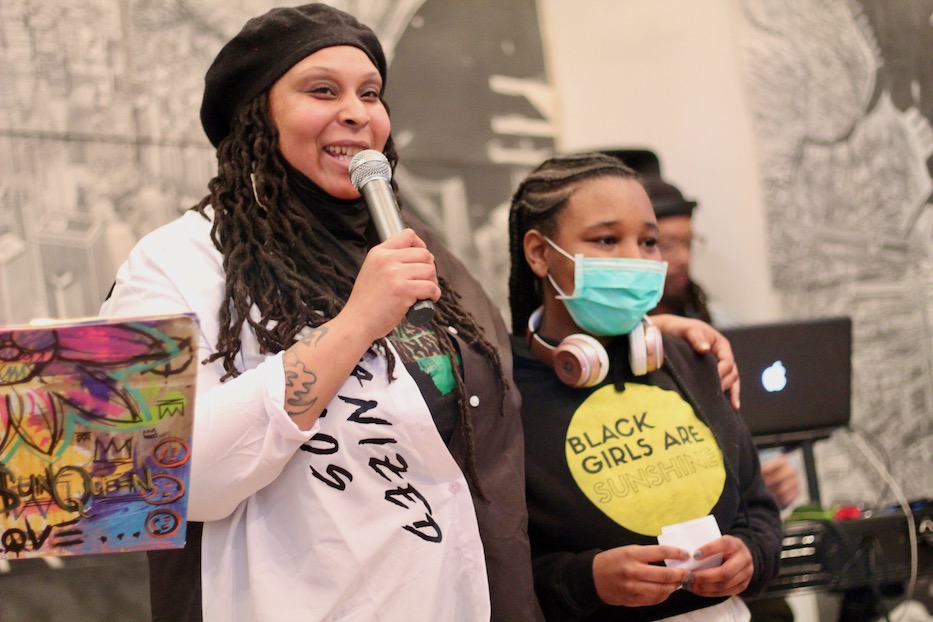
Black History Month | Culture & Community | Hill Museum of Arts | Krikko | Music | Poetry & Spoken Word | Arts & Culture | The Hill | Arts & Anti-racism
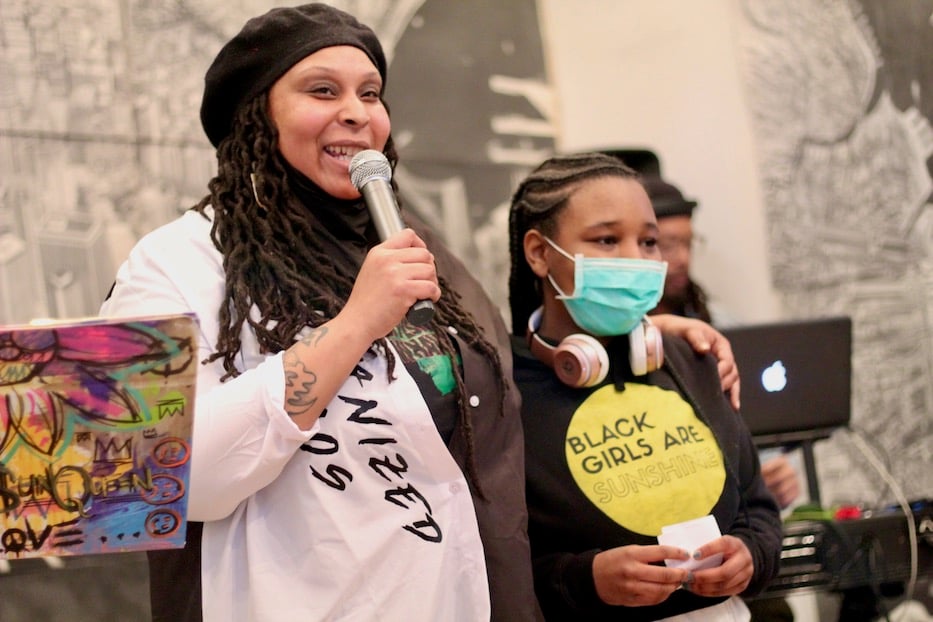
Sun Queen and her goddaughter, Ka'meya Ingram. Ingram's sweatshirt is part of Sun Queen's "Black Girls Are Sunshine" brand. Lucy Gellman Photos.
Sun Queen lifted the microphone to her mouth, the words already dancing on her tongue. In front of her, four dozen faces looked back, waiting for her to speak. Behind her, a pencil drawing of New Haven stretched across two stories, tiny graphite people walking along its tidy, wide graphite streets.
“Black love!” she cried, moving with the weight of the words. “Black power!” attendees shouted back.
That joyful noise filled the Hill Museum of Arts Saturday afternoon, as over 50 attendees gathered at the space for a celebration of poetry, music, and dance titled “Poetry In Black.” Part salon, part dance party, and part spoken word performance, the event brought together creatives from across the city to both fête and amplify Black joy.
It received support from Black Lives Matter New Haven (BLMNHV), Long Wharf Theatre, and the City of New Haven’s Department of Arts, Culture, & Tourism.
“This last year has been rough,” said BLMNHV Co-Founder and poet Sun Queen, who organized the event. “It is a must for Black people to find joy, to center joy, to be in a space where they can breathe. Today, this community gives me joy. It’s a blessing to be among the living and so while I’m among the living, I may as well make it count.”
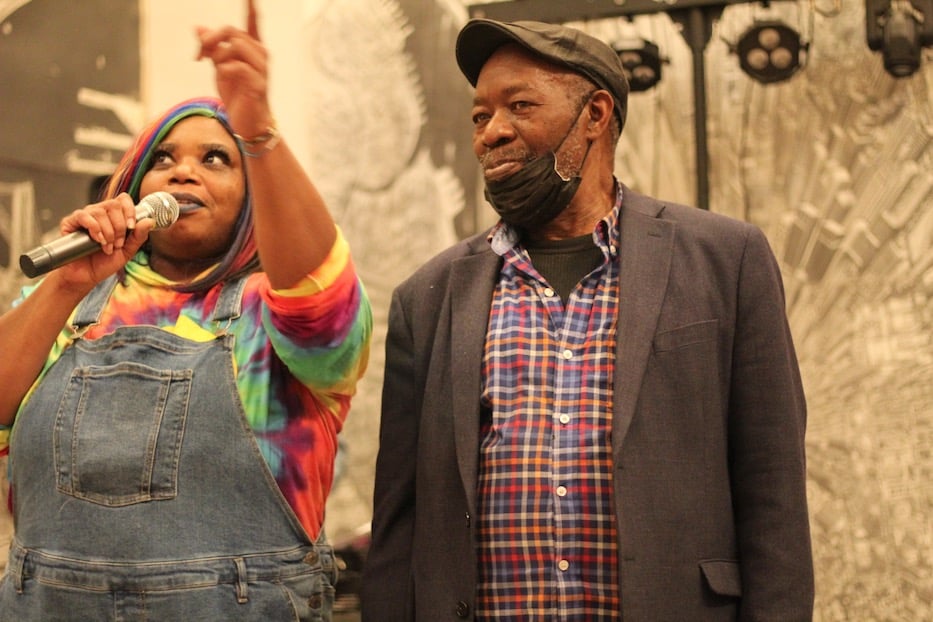
Marcey Lynn Jones and Krikko Obbott. Lucy Gellman Photos.
The space holds significant weight for BLMNHV. In 2016, the group held its first anniversary in the museum, among Krikko Obbott’s enormous pencil drawings and a foundation that he laid himself, and opened to the community in 2013. That anniversary led to the group’s Melanin Unplugged series in Westville, which braved the online pivot during the first years of the pandemic.
Coming back to the museum feels like home, she said. In a city where it’s hard for artists to find affordable event space, Obbott has created it. He is in the process of building out apartments for artists on West Street, for which he won approval from the city’s Board of Zoning Appeals last month. Saturday, he welcomed artists back with wide-armed hugs, beaming as he pulled out his phone to record almost every performance.
Throughout the afternoon, artists captured that joy in song, poetry, explosive movement, and speech. As lifelong New Havener Manny James Sorrells walked toward the mic, he took a deep breath in, then loosed a songbird from his throat. Lift every voice and sing/Til earth and heaven ring! he began, and within seconds every eye in the room was on him.
His voice bloomed in the space, smooth as butter with an edge that flickered blue and orange. Sing with the har-mon-ies of liberty!
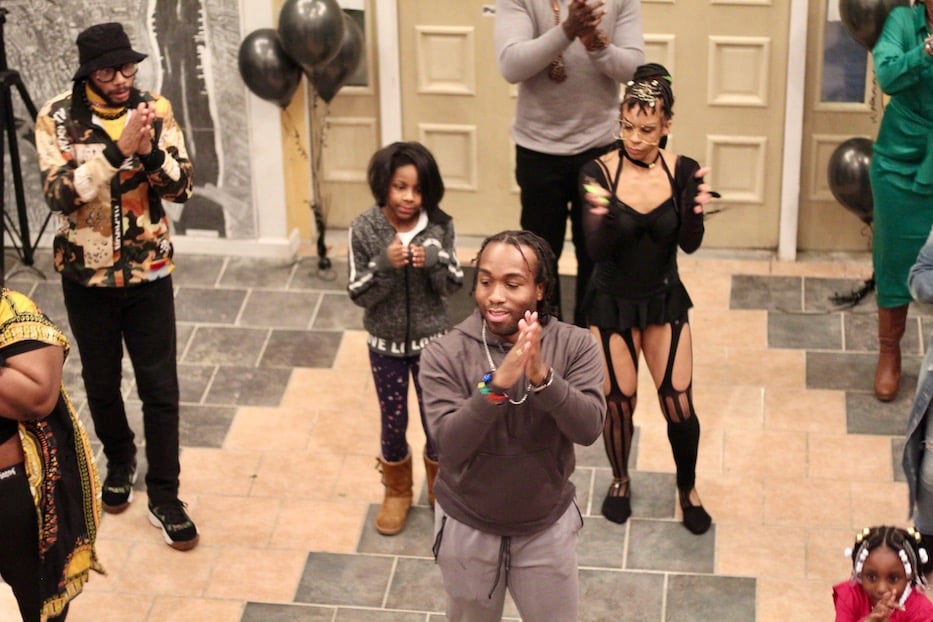
Earl Ali-Randall teaches dance. Lucy Gellman Photos.
In the sudden quiet of the museum, where Roman columns and a winding staircase soar towards the high roof, his voice filled every corner, floating up the stairs. When he belted Let our rejoicings ri-iii-iiise!, holding the high note, every face in the audience lit up. When he slowed to sing the refrain, attendees let themselves savor every word. When he finished, the room burst into applause.
“That was just like, in the living room, in the kitchen, at church, in the Hill museum. That was … yeah,” Queen said, tapping her chest where her heart lay beating beneath her sternum. “That came from somewhere, like, past the soul.”
Still humming “Lift Every Voice and Sing” (“Y’all know how I’ll be in my shower tonight,” she said to a wave of laughter), Sun Queen welcomed City Cultural Affairs Director Adriane Jefferson to the mic, thanking her for the work she has done to foster cultural equity in New Haven.
To a call-and-response of “Black History!/365!” from Queen, Jefferson approached the mic, reminding attendees of the power of art and artmaking as a form of activism. As a city employee who began her tenure at the beginning of 2020, Jefferson has lived that vision, with public art projects dedicated to supporting Black artists across the city.
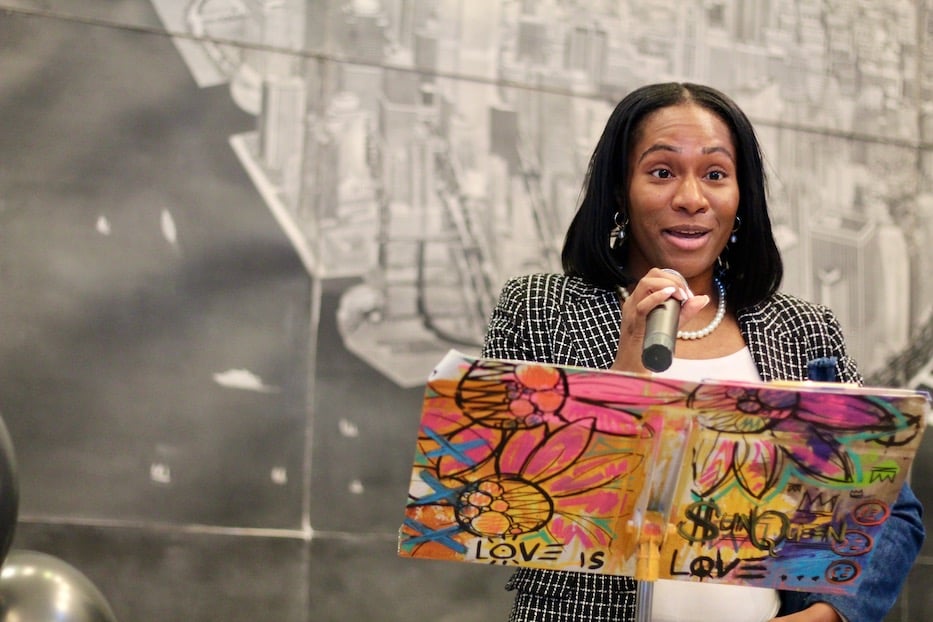
City Cultural Affairs Director Adriane Jefferson. Lucy Gellman Photos.
“If you look at Black history, we have been at the forefront of movements and revolutionary change,” she said to applause. “It is powerful what we’ve been able to do.”
She took it back to the heartbeat—the African drum, and its centuries-old role in African dance, song, storytelling and oral tradition. “When we were ripped from the motherland and brought here, we carried that over with us,” she said.
She traced a line from oral tradition to the use of hymns as a musical map to freedom, from Reconstruction to Civil Rights, from African American spirituals and poetry to the roots of hip-hop in a Bronx rec room in the early 1970s. Just as Black history is American history, she reminded listeners, American music is Black music. The two are intrinsically, and sometimes painfully, bound.
“It is a history of music and culture and film that has carried us through to telling our stories and our narratives,” she said to snaps. “Those same hymns that turned into jazz, and hip-hop, and gospel, and country, which by the way we did found—”
“Okay sis!” Queen cried from the back.
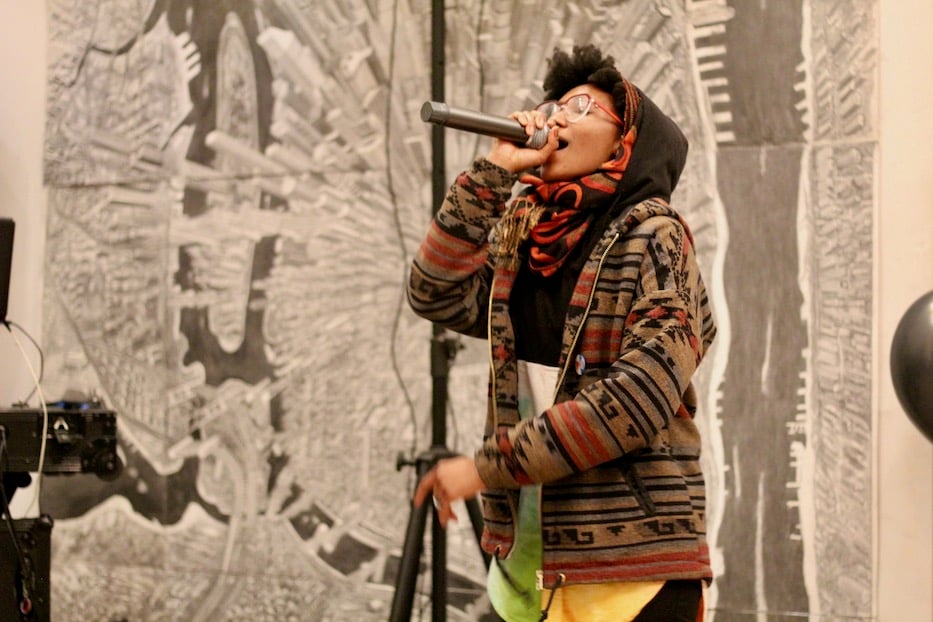
Anne Gogh reading. Check out the video at the bottom of the article for her performance. Lucy Gellman Photos.
“This is something that is just a part of who we are,” she continued. “Telling our narrative. Reclaiming our stories. Cultural preservation because the white media wasn’t telling our stories the correct way. They really still don’t, right? So we had to take control. And that’s what arts and culture has done for us.”
She pointed to one of her favorite films, John Singleton’s 1991 Boyz n the Hood. Over three decades after it was first released, the movie has stayed with her. She often comes back to the scene with Doughboy (Ice Cube) and Tre (Cuba Gooding, Jr.) sitting on a front porch in the rising L.A. heat, discussing the murder of Ricky Baker. “Either they don't know, don't show, or don't care about what's going on in the hood,” says Doughboy.
For her, it’s a call to communal and intergenerational storytelling among Black people and Black families, from oral tradition to film, photography, and visual art. If stories aren’t preserved and passed on, she asked, who will do that work? As if on cue, the artist Candyce “Marsh” John added the outline of three young faces to a bright canvas that would soon bear the words of James Baldwin.
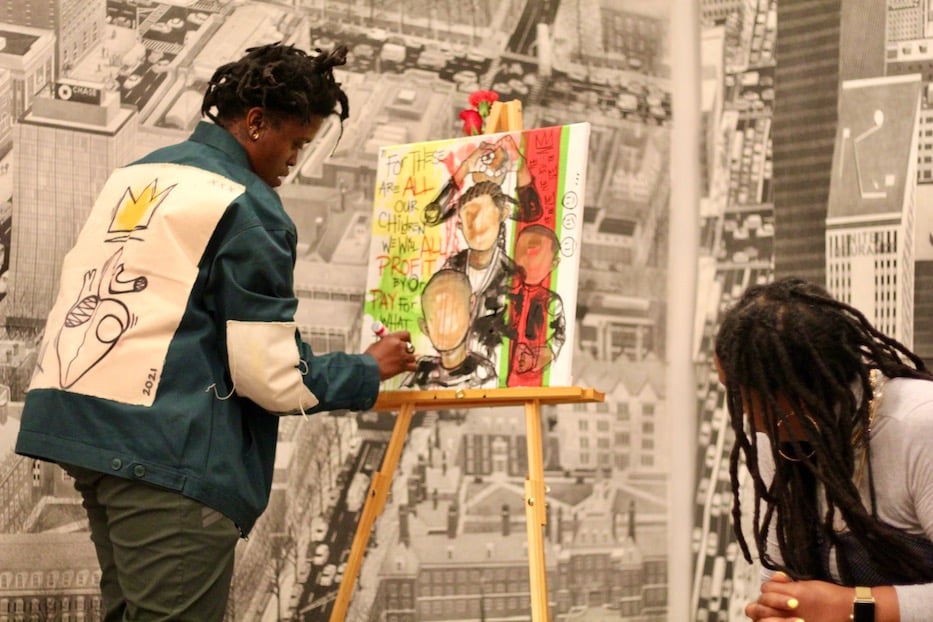
Marsh works on a painting that she auctioned off at the end of the night. Lucy Gellman Photos.
Back at the mic, Jefferson stressed the need to tell more stories of Black resilience, Black love, Black dignity and Black joy.
“That’s what these mediums can capture, it literally is us. It is living history in this room,” she said. “Black history is not just today. It is not just this month. It is every single month, 365 days of the year.”
As she headed back to her seat, BLMNHV co-founder Ala Ochumare and organizer Marcey Lynn Jones emerged from the wings with red roses and carnations, drifting through the audience as they handed out the flowers to attendees. As red petals dotted the crowd, Queen and her goddaughter, Cooperative Arts & Humanities High School student Ka'meya Ingram, wrapped the audience in each stanza of the poem “My Black is Beautiful.” Queen later returned to the mic to read; a video of that performance is at the bottom of this article.
Marsh, whose public art footprint has criss-crossed the city in recent years, placed two flowers gingerly at the top of her easel, and continued to work on a live painting. When she began thinking about the piece earlier this month, she said, she looked to Baldwin’s legacy for guidance. She found in his words —For these are all our children, we will all profit by or pay for what they become—the inspiration for her piece.
“I’ve always loved kids and I’ve always worked with kids,” she said, adding that she worries young people are distracted by social media, and don’t recognize how strong and precious they are. “I want to illustrate Black joy for children.”
“We Will Not Be Silent”
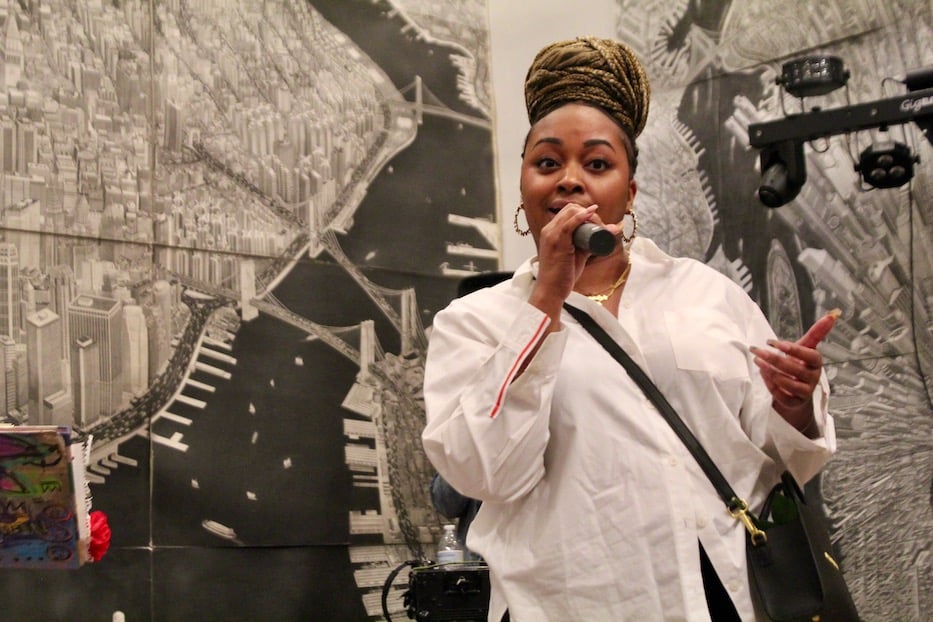
Attallah Sheppard: We will not be silent. Lucy Gellman Photos.
That hope for the future flowed through poetry and spoken word performances from Queen, Attallah Sheppard, Anne Gogh and Ochumare, the last of whom was performing for the first time Saturday.
It undulated beneath, over and through the audience during dance and hoop interludes and lessons from Earl Ali-Randall and Diamond Tree, the beat of the drum weaving through it all. It even slipped into a rendition of “Happy Birthday” for Ali-Randall, as DJ R-Nice sent a spray of bright light onto the walls.
Taking the mic off its stand, Sheppard looked over the audience, and then dropped a whole sermon, bar by tight, lyrical bar.
“When they view you as two-fifths less than whole/Just know/They been trying to fracture your soul,” she started, as snaps permeated the audience, and echoed beneath the high ceilings. “Racist patrollers/Been acting as mathematicians/Their job has always been to subtract our roles.”
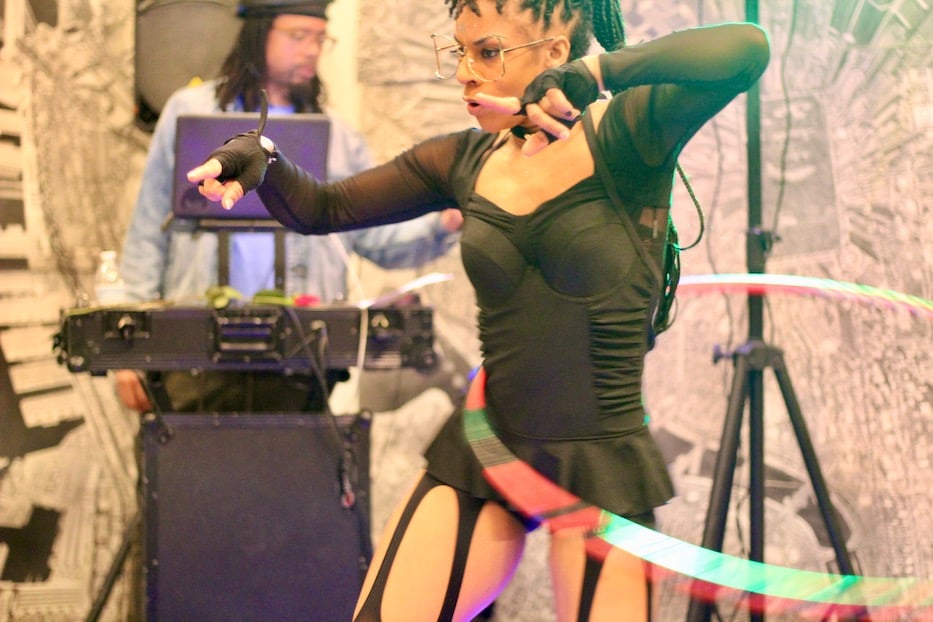
Diamond Tree performs Saturday. Lucy Gellman Photos.
She cleaved past and present in two, tracing the theft of people and land to enslavement, centuries of Black resistance, and modern-day policing. She jumped to the present, tying together the parallel pandemics of Covid-19, police brutality and white supremacy. She praised her parents for teaching her to speak out, to respect herself, to call racism by its name and work towards a future without it.
When she declared, “I don’t make time for small talk/Speal big around me,” the audience whooped and whistled back. When she raised one fist above her head, the other wrapped tightly around the microphone, the crowd cheered, a few cries of “Yes!” and “Okay!” popping up from the back rows and staircase where Obbott stood.
In one fell swoop, she debunked the need for white comfort and allyship, asking for accomplices instead. She folded in a chess metaphor, nimbly moving her pawns across the board and praying for their survival with each word. By now, the audience was responding to every line. Inside the museum, where every word bounced off the walls, Jefferson’s earlier call to activism cracked to life.
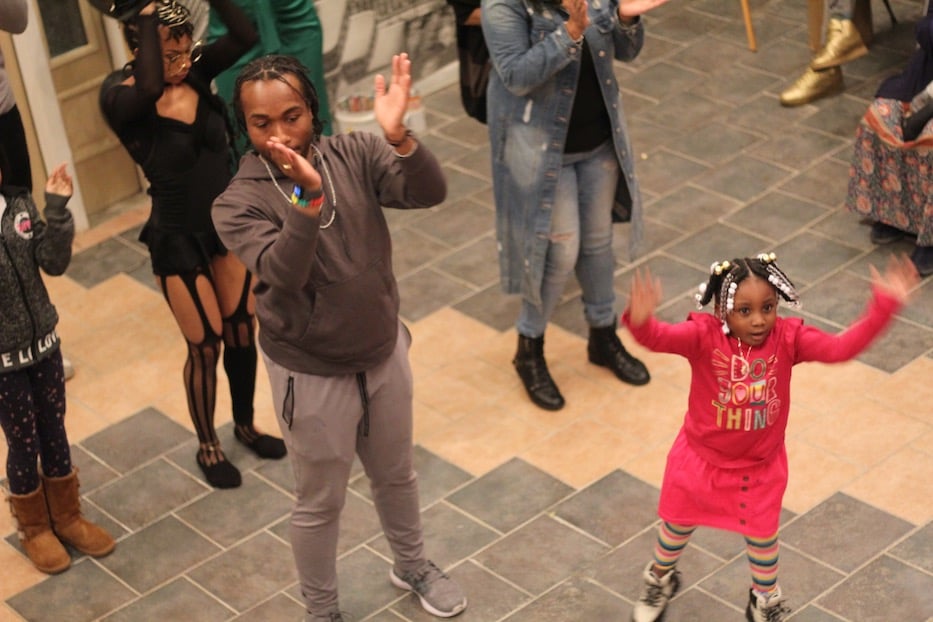
Earl Ali-Randall teaching.
“This poem be a riot,” Sheppard read. “Be a rally. Be a war cry. Be evidence of the unrest that continues to be dismissed. Be a reminder that even in the face of this consistent injustice, we will not be silent. No we will not be silent/No, we will not be silent.”
“Run that back!” someone yelled from the side of the museum, where a huge bird’s eye view of New Haven hung from the wall. Smiling, Sheppard returned to the stage, and picked up the last third of the poem. At the end of the piece, the applause rang through every square inch of the museum.
Others danced it out. Clearing the floor, Ali-Randall walked attendees through the steps of African dance, every body part electric as he moved. Diamond Tree, who runs Hood Hula, also invited attendees to join her, laughing out loud as some of the youngest in the crowd jogged forward on their certain, little legs.
Between affirmations and poetry, Ochumare cautiously approached the mic. Even after years organizing in the streets, behind the scenes and as a mentor for dozens of New Haven’s youth, she said, she still gets nervous speaking in front of people. As she read, she described herself as lost in translation, trying to find the right words to undo systems that have upheld white power, often and overwhelmingly at the cost of Black life and safety.
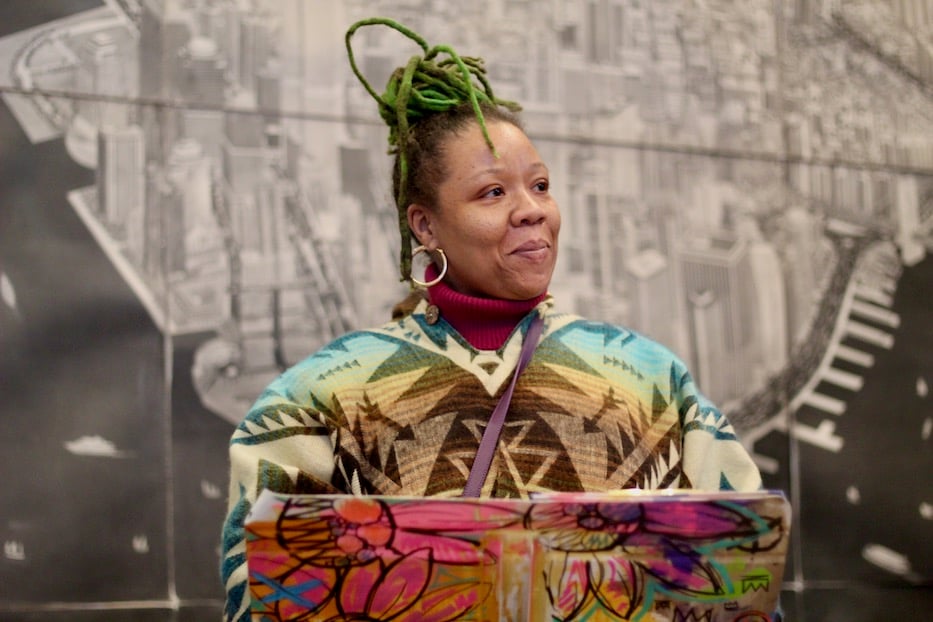
Ala Ochumare, who co-founded BLMNHV with Sun Queen.
Like Sheppard, she pulled apart time and space, explaining that as a Black person, she feels at once the loss of 404 years of history and the still-painful and exhausting reality of the present. Black people are still dying at the hands of police. The country’s social safety net is riddled with holes through which people may fall. Meanwhile, she sees appropriation of Black culture alongside the cruelty of white supremacy.
“We aren’t as desensitized as you want us to be,” she read. “We just waking up. We can’t pretend this isn’t happening anymore. There’s a hit out on all Black lives. Our salvation is lost in translation.”
She isn’t overly pessimistic, she later said: she’s just aware of the work ahead. Before the end of the night, she was back in front of the audience, this time to auction off the painting that Marsh had completed. “We are paying Black artists while they are still here,” she said.
Before the end of the night, Queen also told attendees to keep an eye on the work of BLMNHV, which has grown from mitten and backpack drives to a steady activist presence both in and out of the streets. Behind her, DJ R-Nice stood at the ready, cuing up music to end the night with a dance party. Jones slid onto a stool by the drums. It seemed like if she wanted to, she could play all night.
Learn more about Black Lives Matter New Haven here.

